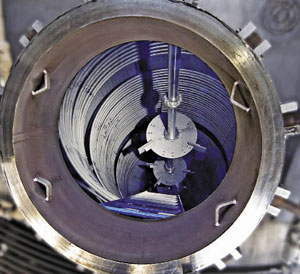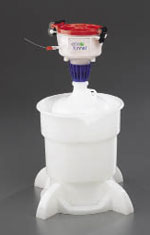Chemical & Engineering News features ECO Funnel Manufacturing Move
Back From China: Manufacturing of pharmaceutical chemicals and related goods is starting to trickle back to the U.S.
Michael McCoy
Chemical & Engineering News April 27 2009 Volume 87 Number 17 pages 16-17
IN 2006
the industrial chemicals company Lanxess disassembled a hydrazine plant
at its Baytown Texas location put the 3000 resulting parts on a boat
and shipped the whole thing to Weifang China. There the company
reassembled the plant and reopened it.
At the time Lanxess' move
seemed emblematic of the rise of China as a manufacturing location at
the expense of more costly and highly regulated countries such as the
U.S. Lanxess said demand for hydrazine was shrinking globally but
growing at double-digit rates
 in China.
in China.
Three years later a recession is tightening its grip on the U.S.
economy. Announcements of U.S. plant closings and workforce downsizing
are almost daily events. At the same time the trend toward China and
other low-cost manufacturing locations continues.
MAPI a U.S.
manufacturers association surveyed members in January and found that 79%
of them have not slowed their outsourcing to East Asia over the past
two years. Only 15% of respondents relocated products or processes from
East Asia back to the U.S. or northern Mexico during that period.
One of the reasons for the migration east is cost. The labor cost
required to produce $1.00 of goods in China was about 20 cents last year
MAPI says. That's up from 13 cents in 2006 but it is still less than
the 48 cents' worth of labor required in the U.S. last year.
Yet
amid the gloom a few stories have emerged of pharmaceutical chemical
companies recommitting to the U.S. as a production location after a
flirtation with China. Although they hardly make a trend these stories
show that given the right circumstances some U.S. firms can compete
against their counterparts in China.
More than two years ago
executives at Pfizer CentreSource the third-party manufacturing arm of
the drug giant embarked on a plan to shift some of the firm's bulk
steroid production from Kalamazoo Mich. to two Asian firms: China's
Shanghai Pharmaceutical Group and Taiwan's ScinoPharm.
Pfizer's
Kalamazoo facility uses fermentation to transform soybean-derived
sterols into a family of four building blocks that are then chemically
converted into finished steroids. Although the fermentation half of that
process boasts unique technology and economies of scale that only
Kalamazoo can offer Jeffery W. Frazier vice president of global fine
chemicals marketing for Pfizer CentreSource says the company figured it
could synthesize the final steroids more cheaply overseas.
Pfizer
worked with the Asian partners advising them on its environmental health
and safety standards and preparing them for the transfer of some
steroid-manufacturing technology. It pared down its steroid product line
to a more manageable size and began informing customers of the
impending change.
But as this process advanced events were unfolding
that caused Pfizer executives to rethink their outsourcing strategy.
The company realized that its new steroid partners would need to make
additional investments in facilities and processes to meet both Pfizer's
requirements and the agreed-upon timetable for production. "Looking at
the combination of the investment that would be required the quality and
environmental issues involved and the delays we decided to maintain
production activities in Kalamazoo" says Michael J. Kosko president of
Pfizer CentreSource.
Frazier emphasizes that the Asian companies are
capable of turning out quality products to industry standards. "But
Pfizer's own internal standards are quite high" he says. "It's an
additional hurdle."
"Fortunately or unfortunately China has a middle class that's growing and costs that are growing."
Alerted
that Pfizer had rethought its Asia plan Kenneth Ball Pfizer
CentreSource's marketing manager for fine chemicals sat down with the
Kalamazoo-based process technology group and launched a competition
among the site's process chemists and engineers to improve the later
stages of steroid synthesis. He set up four teams to develop new
processes in parallel. The competition was fierce but it was friendly
enough that the teams kept their counterparts apprised of what they were
doing.
The result according to Ball was improved bulk steroid
chemistry that's both cheaper and greener. In the synthesis of
testosterone for example Pfizer scientists eliminated a hazardous
reagent thereby allowing them to move manufacturing out of a specially
controlled reaction vessel and into a more flexible general-purpose one.
Other recent changes at Pfizer also support the new approach to steroid
manufacturing. The Kalamazoo site has been reaping the benefits of
operational excellence programs implemented across the firm's
manufacturing locations. As it turns out Kosko says these benefits were
both important and timely. "They gave us additional options for
competitive pricing after our outsourcing plans had changed" he says.
And Pfizer's formation of a new business unit for established
productsâ€âits name for off-patent or generic drugsâ€âhas boosted the
role of the Kalamazoo site within the corporation Kosko points out. "We
have for the first time an organization charged with promoting and
growing products that are off patent" he says. "With this alignment we
have a strategic view of the future for the site."
Pfizer has
piloted and validated the new steroid process Ball says and is now in
the midst of its first full manufacturing runs. Customers have been
receptive to the decision to stay home he adds. "It has to do with the
Pfizer brand. We have an impressive facility and staff. Customers can
see and talk to what's behind the product."
LOCAL PRODUCTION
has always had an appeal and it may be growing stronger in these
uncertain economic times. James Bruno managing director of Chemical
& Pharmaceutical Solutions a New Jersey-based consulting firm
confirms that some of his drug and biotech industry clients are turning
to established U.S. manufacturers for their pharmaceutical chemical
production.
Ironically one of the reasons is cost. Although
long-term chemical manufacturing in China is often cheaper than in the
U.S. establishing a solid relationship and ensuring quality and security
of supply can involve expensive consultants and a lot of overseas
travel.
Bruno tells of one emerging pharmaceutical company that does
plan to outsource to China eventually. "But they feel in the short term
that it will be cost prohibitive" he says. The cost of auditing a
facility in China was one consideration Bruno says as was the additional
time that could be required to scale up synthesis with a far-away
contractor.
Another client a generic drugmaker recently canceled an
order with a Chinese supplier and turned to a Western pharmaceutical
chemical maker. "They were concerned they weren't going to get the
quality they needed" Bruno says. They also worried that process
development would take too long he adds.
Chinese regulatory
authorities and the U.S. Food & Drug Administration are taking steps
to improve the quality of China's drug supply in the wake of last
year's heparin and melamine contamination scandals. Bruno agrees that
these initiatives will eventually improve confidence in Chinese
pharmaceutical manufacturers but he says the scrutiny could prove
disruptive for potential customers in the short term.
For Ramin
(Ron) Najafi an entrepreneurial chemist the safety or quality of Chinese
goods was never a problem. He recently moved manufacturing of his
company's product line from China to a California firm mainly because of
costs.
 Najafi formed CP Lab Safety
in 1996 while he was a researcher at Applied Biosystems a supplier of
instruments and other tools to biotech researchers. By the 1990s
chemists had abandoned the practice of dumping used organic solvents
down the drain. Instead at Applied's labs and elsewhere they would pour
spent solvent into jugs kept under the fume hood. But left in an open
jug with a funnel on top the solvent would eventually evaporate up the
hood.
Najafi formed CP Lab Safety
in 1996 while he was a researcher at Applied Biosystems a supplier of
instruments and other tools to biotech researchers. By the 1990s
chemists had abandoned the practice of dumping used organic solvents
down the drain. Instead at Applied's labs and elsewhere they would pour
spent solvent into jugs kept under the fume hood. But left in an open
jug with a funnel on top the solvent would eventually evaporate up the
hood.
Najafi came up with the idea for the Eco Funnel a high-density
polyethylene device that screws into the top of the jug. Solvent that's
poured in can't evaporate back out. Applied allowed him to patent the
funnel and later agreed to buy some of them for its labs.
After two
less than satisfactory earlier generations Najafi perfected an
injection-molded version of the funnel in 2000. He turned to a
contractor in China's Guangdong province to produce it because at the
time prices from local manufacturers were too high. "You couldn't touch
anything in the U.S." he says.
But as time went by prices and
shipping rates from China kept escalating. Last year Najafi and CP's
chief executive officer Kelly Farhangi decided to talk again with
Wright Engineered Plastics
a Santa Rosa Calif. firm they had worked with in their early days. They
found that the cost of local manufacturing had become competitive with
China without the hassle of an overseas relationship.
Wright is now
gearing up to manufacture all 80 products in CP's line. Najafi says the
move was motivated purely by economics. He never had a problem with the
quality of the Chinese-manufactured funnel and says he is grateful to
the companies in China that helped his firm get by in its early days.
"China makes good stuffâ€âthe iPhone for example" Najafi says. "But
you have to keep on top of it and there is a cost to do this. You can
handle it when you are a big company with a high-volume product but for
smaller firms the economies of scale are not always there."
Barbara
Roberts Wright's CEO contends that decisions like the one Najafi made
are becoming more common. "I think there is a growing trend to either
return to the U.S. or not take products overseas" she says. Buyers at
midsized companies are factoring in shipping costs the logistics of
container-load shipments and the expense of sending quality-control
people to plants in China. They are concluding that small price
differences aren't worth the hassle she says.
Najafi agrees. "Our
manufacturer is now in our backyard. Communication is not an issue and
we expect higher quality" he says. "I think a lot of American companies
are missing out on this."
Bruno the consultant sees stories such as
Najafi's as part of a larger turning of the tide in global
manufacturing. "Fortunately or unfortunately China has a middle class
that's growing and costs that are growing" he says. "China is also a
large market. We should be looking at it as more than just a low-cost
manufacturing site."
Recent Posts
-
Disinfecting Surfaces in the Era of Covid and EPA Registered Commercial Disinfectants and Viricides
The disinfection of surfaces at home, in public spaces, and in hospitals and clinics needs to be a …15th Jan 2023 -
Working with Inorganic Acids in the Laboratory: A Practical Guide
Working with Inorganic Acids in the Laboratory Acids are of great importance in the laboratory and a …5th Jan 2023 -
The Top 12 Drinking Water Contaminants
1.Lead- from older plumbing systems pre-1986, when lead pipes, solder, and components were banned. …14th Dec 2022
